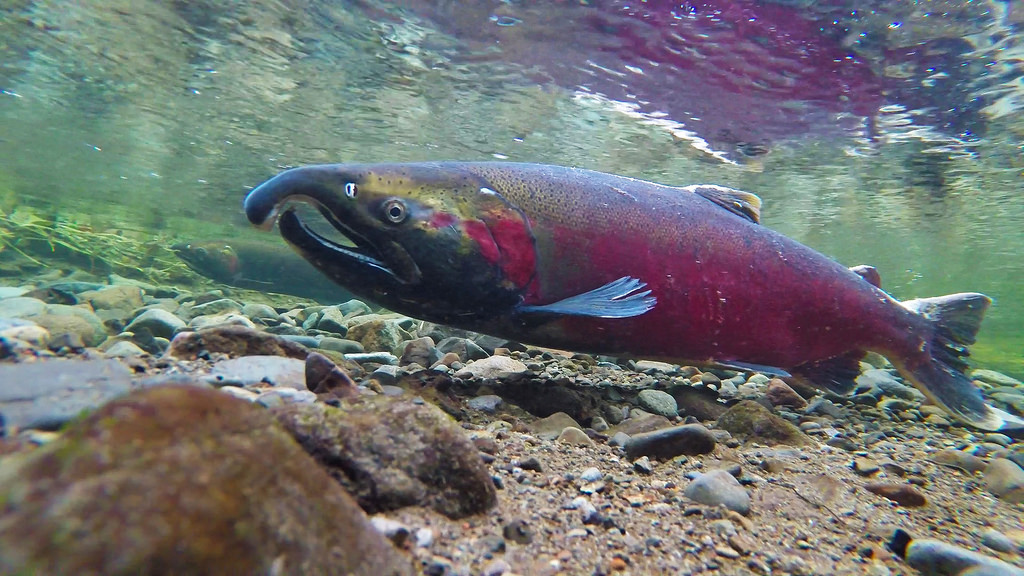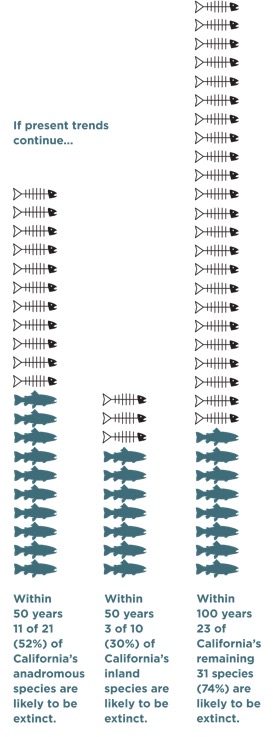June 05, 2017 | Water in the West | Insights
 The shift in California from extreme drought to extreme wet weather has been a bumpy ride to say the least—from parched reservoir beds to the near calamity at Oroville dam. Unfortunately, a growing body of research shows that these pronounced extremes of wet and dry weather will only continue to grow in the future. With years of drought impacting agriculture in the state, much has been made about the role that fish—and perhaps more to the point, peoples’ concerns about fish—have played in limiting deliveries of water to irrigators. In this dichotomized vision of water management in California (and throughout the Western U.S.), our fish have effectively been pitted against our farms. Yet this approach fails to fully recognize the complexities of how water is actually allocated, in both wet years and dry, and diverts attention from water management solutions that could benefit humans and the environment.
The shift in California from extreme drought to extreme wet weather has been a bumpy ride to say the least—from parched reservoir beds to the near calamity at Oroville dam. Unfortunately, a growing body of research shows that these pronounced extremes of wet and dry weather will only continue to grow in the future. With years of drought impacting agriculture in the state, much has been made about the role that fish—and perhaps more to the point, peoples’ concerns about fish—have played in limiting deliveries of water to irrigators. In this dichotomized vision of water management in California (and throughout the Western U.S.), our fish have effectively been pitted against our farms. Yet this approach fails to fully recognize the complexities of how water is actually allocated, in both wet years and dry, and diverts attention from water management solutions that could benefit humans and the environment.
Fish are no small concern economically or otherwise—a recent press release by the American Sportfishing Association and Southwick Associates indicated that California’s roughly 2.8 million anglers (in combination with industry-related jobs) have a combined $4.6 billion impact on the state’s economy. However, both long-term water use as well as the drought have affected fish severely. Even with the historic precipitation this past winter, Governor Jerry Brown recently joined Oregon Governor Kate Brown in asking the U.S. Secretary of Commerce for a disaster declaration due to an unprecedented low in the population of ocean salmon. Earlier this year, the Pacific Fisheries Management Council ordered the closure of the 2017 commercial fishing season for Chinook salmon along 200 miles of the California coast because populations of that species have been decimated by the drought.
Further supporting this call to action across the state is a sobering 2017 report jointly published by CalTrout and the UC Davis Center for Watershed Sciences. The report suggests that under present conditions California is likely to lose 45% of its native salmon, steelhead and trout in the next 50 years (Figure 1).

Figure 1: Predictions for loss of fish species in California under current conditions.
Courtesy: State of the Salmonids II: Fish in Hot Water Report by CalTrout and UC Davis Center for Watershed Sciences.
Meanwhile, in April the Bureau of Reclamation announced that irrigators on the west side of the San Joaquin Valley would get 100 percent of their water allocations from the Central Valley project. California’s wet winter will provide some relief to farmers, if not to fishermen. This is not to say that both groups have not been impacted by the drought, but it certainly challenges the idea that fish are impeding surface water deliveries across the board. Moreover, even if we were to believe the narrative suggesting that California’s water management is indeed fish versus farmer, this growing body of evidence suggests that the fish aren’t necessarily winning.
Missing from all of this discussion is a well-articulated, thoughtful way forward for California. While there is concern about environmental groups stopping the development of surface water storage and preventing deliveries of water to farmers, the reality is much more complicated. California has not built any new storage projects in part because of environmental concerns, but also because the additional storage—and the benefits of that storage—do not justify the extremely high costs of dam construction. The delivery of water south of the San Francisco Bay Delta to Central Valley farmers also involves an exceedingly complex menu of factors, including smelt and salmon, but also including water quality for irrigators in the Delta. Blaming environmentalists for this constellation of factors misses the point and just perpetuates the exceedingly unhelpful level of finger pointing in California.
Moreover, the emphasis on surface water storage fails to substantiate perhaps the brightest path forward for water users, particularly Central Valley farmers— groundwater recharge and storage. Surface water storage has major shortcomings in dealing with weather extremes: in a long drought, reservoirs do not fill up. More reservoirs just mean more empty space. In an extremely wet year, they fill up very quickly, and then they spill over (just watch videos of the catastrophe at Oroville dam). If we put water in the ground however, and use it to recharge California’s depleted aquifers, it will stay there as long as we need it, and serve as a water bank for the next drought.
Reducing a problem as complex and fraught with tension as water management in California necessitates an appreciation of nuance. The old adage that “water is for fighting over” is tired. Rather than fall back into the same patterns of blame and condemnation, the state should be strategically focused on building new infrastructure that will increase its groundwater recharge capacity.

![[Woods Logo]](/sites/default/files/logos/footer-logo-woods.png)
![[Bill Lane Center Logo]](/sites/default/files/logos/footer-logo-billlane.png)